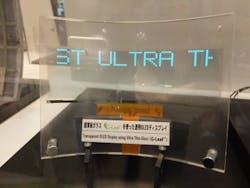| A flexible OLED display is made with 50-μm-thick glass. (Image: Tech-On!) |
As noted in Tech-On!, Nippon Electric Glass (NEG; Ōtsu, Japan) exhibited what it claims is the world's thinnest glass plate -- "G-Leaf" glass plate with a thickness of 30 μm -- at Ceatec Japan 2014 (Oct 7 to 11, 2014; Chiba Prefecture, Japan).
NEG makes ultrathin glass plates to be used as substrates for flexible displays, functional glass materials, and so on. At the trade show, the company also introduced a flexible OLED display made by using a 50-μm-thick version of G-Leaf.
Overflow method
NEG manufactures ultrathin glass plates via a technology called the "overflow method." The company succeeded in making a glass plate having a uniform thickness of 30 μm by adjusting the temperature at which glass is manufactured and the speed at which it is stretched.
Ultrathin glass plates are expected to be used as the substrate materials of flexible displays. Though plastic materials are often used for the substrates of flexible OLED displays, they transmit oxygen, water vapor, etc., accelerating the deterioration of light-emitting elements. Therefore, it is necessary to form a gas-barrier sealing layer on a plastic substrate, increasing costs. On the other hand, an ultrathin glass plate functions as a gas barrier, eliminating the need for the gas-barrier sealing layer.
Source: http://techon.nikkeibp.co.jp/english/NEWS_EN/20141011/382042/
